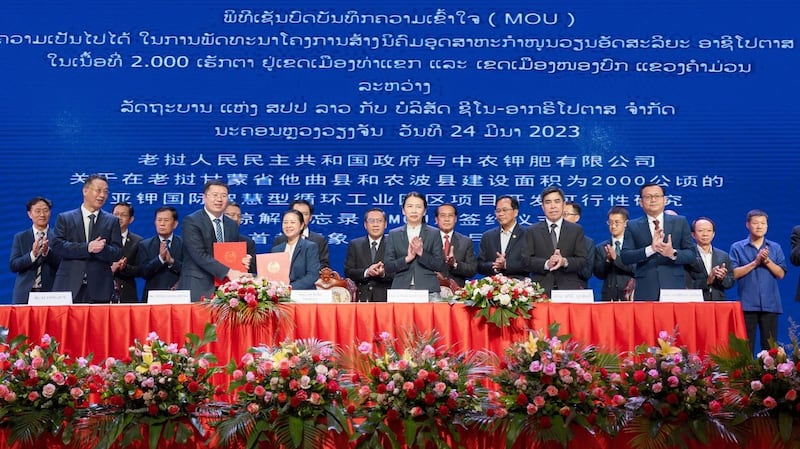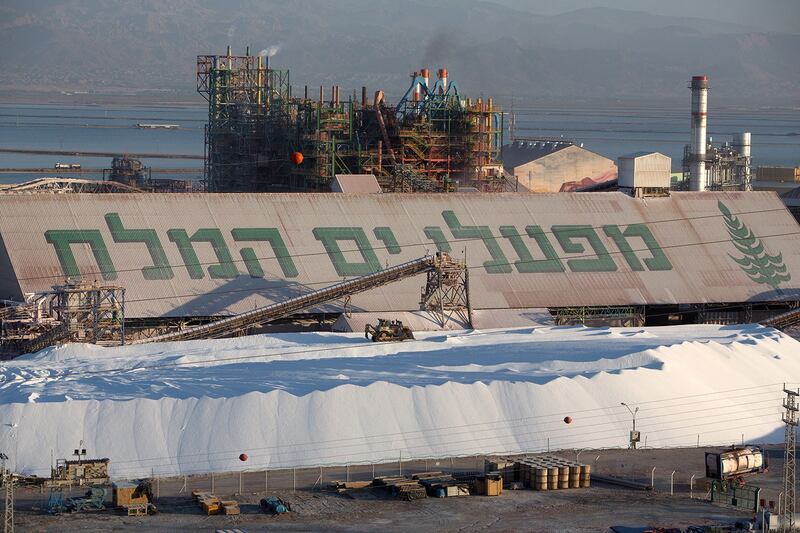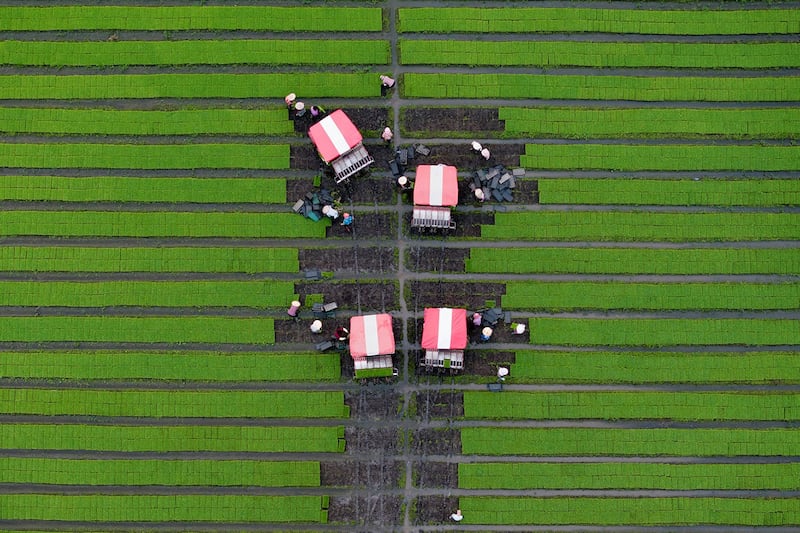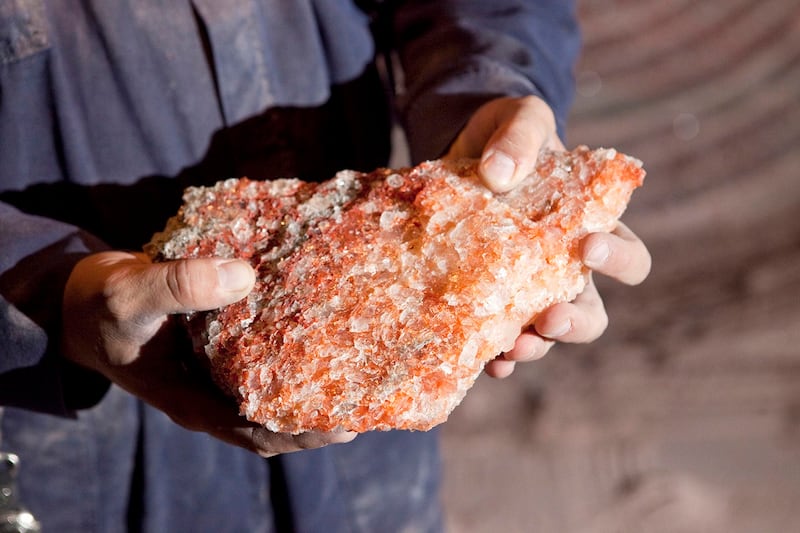Let’s start with the good news – potentially great news, in fact – for Southeast Asia: Laos could be sitting on 10 billion tons of potash, one of the three main fertilizers used in global agriculture.
In 2022, a subsidiary of the Chinese company Asia-Potash International announced a $4.3 billion investment in a potash mining venture in Khammouane province. This deal grants exploration rights to 48 square kilometers for potassium ore.
The company reckons it can start with producing 1 million metric tons of potash annually, scale up to 5 million tons by 2025 and eventually reach 7 to 10 million tons. For a comparison, Canada, the world's largest potash producer, exported around 23 million metric tons, valued at approximately $6.6 billion, in 2023.
In 2022, Laos's potash exports were valued at approximately $580 million, representing about 1.7 percent of global supply. It isn't inconceivable that Laos will become a global player.
Location helps Laos
Geography is key. Next door is China, the world's largest importer of food and food inputs, and the world's third-biggest purchaser of potash. China imports around 8 million metric tons each year, about half of its demand, although that is increasing.
China is the world’s biggest producer of potatoes, which are very reliant on potassium. China’s potato heartlands – Yunnan, Guizhou and Sichuan provinces – are on Laos’ doorstep. Guangdong province, China’s main banana producer, isn’t too far away.
There's ample room for Laos to expand potash exports in Southeast Asia, too. Indonesia, the world's fourth-largest potash importer, bought around $2.1 billion worth in 2022, with Laos holding a 6 percent market share.
Malaysia, the sixth-largest importer, spent around $1 billion on potash, with Laos having a 2 percent share. Laos is already the largest supplier of potash to Vietnam, with exports worth about $82 million in 2022.

If, for instance, Laos was to replace suppliers like Jordan and Israel and capture a 20% share of China’s potash import market, its exports could rise to around US$750-800 million, making potash Laos’ second-largest export product, after energy.
Right now, the spot price for potassium chloride is US$307 per metric ton. So, loosely, 10 million tons exported a year would bring in around US$3 billion.
Expectations shouldn’t be that high, though. It’s one thing for a Chinese investor to promise to produce 10 million tons a year and it’s another thing for it to actually deliver it.
And because it's a Chinese firm selling the goods, most of the money won't stay in Laos. And there are already the same complaints as with every Chinese investment: Asia-Potash International isn't hiring local workers.
Geopolitics
Nonetheless, estimates vary, but there still could be between $30 million and $300 million in annual revenue for the Lao state. Almost certainly it will be towards the lower end, but it’s not to be sniffed at by the badly-indebted government.
However, consider the geostrategic implications.
Up until now, China hasn’t really needed Laos. It lacks the strategic importance of Cambodia, with its naval base on the Gulf of Thailand, or the trade routes offered by Myanmar, where China is developing a $7 billion port to access the Indian Ocean for oil and LNG imports from the Gulf.
In 2022, Laos accounted for a mere 0.1 percent of China's total imports; food makes up less than a tenth of that, so Laos isn't a solution to China's future food insecurity.

China’s primary import from Laos is pulped paper, not energy. Instead, China constructs hydropower dams and coal-fired stations in Laos, which generate electricity sold to Thailand and Vietnam.
Geostrategically, Laos is a useful ally for Beijing to have because of its ASEAN membership, but Vientiane holds little weight in the regional bloc.
Should something drastic occur in Laos – such as the fall of the ruling communist party or the emergence of an anti-China government – Beijing would be displeased and Chinese investments would be at risk, but China's national security would be unaffected.
That situation changes if Laos becomes a significant supplier of potash. If projections are correct and Laos can produce between 7-10 million tons of potash annually, it could theoretically more than meet China’s entire import demand. That makes Laos a national security interest for Beijing.
Food security
The Chinese government is preparing itself for military conflict. It knows that in the event it launches an invasion of Taiwan or attacks a rival state in the South China Sea, the West will hammer it with economic sanctions so damaging it would make the retribution reaped on Russia look like a slap on the wrist.
Self-sufficiency and diversification are the buzzwords. But it’s doubtful that China – arguably the country most dependent on world trade and on U.S. protection of shipping routes – could survive such sanctions.
Even short of war, food security has long been a major concern for China., for reasons too long to go into. According to Xi Jinping, the supreme leader, food security is the "foundation for national security."
Beijing is also concerned that its reliance on imported fertilizer inputs "could pose a major threat to its food security". There's no way China can achieve the food self-sufficiency that Xi wants, as was spelled out in a detailed study by the Center for Strategic and International Studies, a U.S. thinktank.

China can domestically produce enough nitrogen and phosphate fertilizers, the latter essential for phosphate-hungry rice. But almost all of China’s phosphate is produced in Xinjiang and Tibet, far away from the rice-growing Han heartland and where the local population is largely hostile to rule by Beijing.
China will remain dependent on imports of potash, which accounts for more than four-fifths of all China’s fertilizer imports. That’s why it has been trying to diversify away from Canada towards countries like Russia, Belarus and Kazakhstan – and now Laos.
In the event of a conflict and Western sanctions, China would immediately lose access to potash from Canada, the U.S., Israel and Jordan – countries that accounted for over half of China's import supply in 2022 .
Sourcing Belarussian and Russian supplies has become more unreliable since the Ukraine War, and both are in competition with one another on that front. That would leave Laos.
Possibly, this could give Vientiane leverage with Beijing. Knowing how important food inputs would be to China in the event of global sanctions, Vientiane might push for major write-offs off part of its high national debt of 130 percent of GDP, most of which is owed to China.
More likely, this would incentivize Beijing to exert a stronger hand over Laos; it means Beijing couldn’t tolerate anything that might affect the flow of potash. That makes the relationship much more imperial.

David Hutt is a research fellow at the Central European Institute of Asian Studies (CEIAS) and the Southeast Asia Columnist at the Diplomat. He writes the Watching Europe In Southeast Asia newsletter. The views expressed here are his own and do not reflect the position of RFA.
